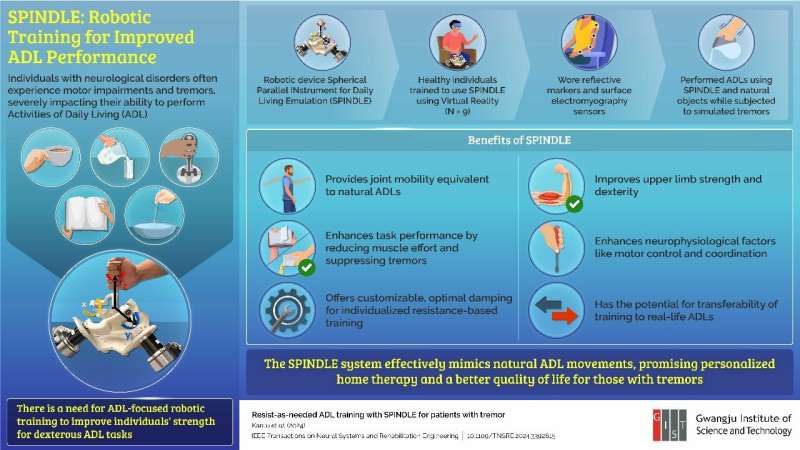This article has been reviewed according to Science X's editorial process and policies. Editors have highlighted the following attributes while ensuring the content's credibility:
fact-checked
trusted source
proofread
Tremor treatment: Researchers develop robotic therapy that improves daily activities

Tremors, or involuntary rhythmic movements, severely impair an individual's ability to perform everyday tasks, reducing their quality of life and independence. In neurological rehabilitation, finding effective treatments is a key goal, and tremor rehabilitation is particularly complex.
Addressing this challenge, a team of researchers at the Gwangju Institute of Science and Technology (GIST) in Korea, led by professor Jiyeon Kang, developed an innovative robotic rehabilitation system to enhance the strength and dexterity of individuals with tremors.
Their research, published on 23 April 2024, in IEEE Transactions on Neural Systems and Rehabilitation Engineering, introduces the Spherical Parallel INstrument for Daily Living Emulation (SPINDLE).
SPINDLE integrates robotics and virtual reality to enhance the strength and dexterity of individuals with tremors, enabling them to perform activities of daily living (ADLs) more efficiently. Unlike traditional methods, SPINDLE simulates ADLs in a realistic and adaptable environment, bridging the gap in replicating real-world tasks' complexity. This innovative system promises to transform rehabilitation for tremor patients, offering a new level of support and effectiveness.
In this study, nine healthy participants were trained to use SPINDLE with the aid of VR technology. Following this training phase, the participants were subjected to simulated tremors and asked to perform various ADL tasks, both with the SPINDLE system and with natural objects. The team meticulously compared the performance results from these tasks to evaluate the effectiveness of the SPINDLE system.
The study revealed several significant benefits of using SPINDLE for tremor rehabilitation. SPINDLE demonstrated joint mobility equivalent to natural ADLs, ensuring practical applicability in real-life scenarios. Participants experienced reduced muscle effort and effective tremor suppression, which contributed to smoother and more controlled movements.
The system provides customizable optimal damping, allowing for individualized resistance-based training tailored to each participant's needs. The use of SPINDLE resulted in improved motor control, coordination, and neuroplasticity, key factors in effective neurological rehabilitation. Participants showed notable improvements in upper limb strength and dexterity, critical for performing daily activities.
"A standout feature of the SPINDLE system is its game-based training paradigm, which allows for varying levels of resistance as needed. This approach not only makes the therapy sessions engaging and enjoyable but also significantly aids in improving the strength and dexterity of individuals with tremors," explains Prof. Kang. By integrating real-time visual feedback and interactive VR elements, SPINDLE ensures sustained user motivation and more effective training outcomes.
"SPINDLE has the potential to significantly improve the quality of life for patients with neurological disorders by focusing on complex ADLs that are difficult for other rehabilitation robots. Its compact design allows for easy integration with TV or VR systems, providing an engaging environment to encourage adherence to rehabilitation programs," adds Prof. Kang.
The promising results from this study indicate that SPINDLE has the potential to become a standard tool in tremor rehabilitation programs. Beyond its immediate applications, the principles and technologies developed through SPINDLE could extend to other areas, such as sports training and injury prevention.
Additionally, the data collected from SPINDLE training sessions can provide valuable insights into neuroplasticity and motor learning, paving the way for more effective treatments for a wide range of neurological disorders.
More information: Nikhil Tej Kantu et al, Resist-as-Needed ADL Training With SPINDLE for Patients With Tremor, IEEE Transactions on Neural Systems and Rehabilitation Engineering (2024). DOI: 10.1109/TNSRE.2024.3392615




















